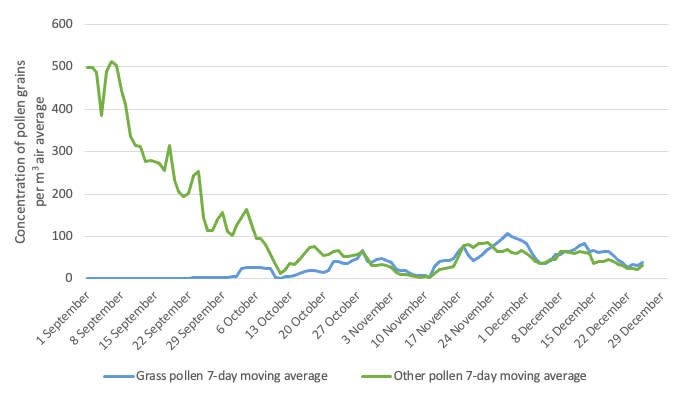Melbourne’s pollen riddle
Feb. 1, 2022
While most of us are familiar with grass pollen and how it triggers hay fever and asthma, researchers find ‘other’ pollen can actually be more abundant in the air
For more than 30 years, the Melbourne Pollen Count has provided daily grass pollen counts and forecasts during spring and early summer. But, as well as grass pollen, we’ve also counted total pollen which includes the sum of grass and all the ‘other’ pollen.
But while most Melburnians are familiar with grass pollen and how it triggers respiratory conditions like hay fever and asthma, they are less familiar with ‘other’ pollen. We call it the ‘other’ pollen riddle because users sometimes ask us if they could be allergic to ‘other’ pollen. We don’t know.
So, let’s look at Melbourne’s pollen, both grass and ‘other’. What’s clear is that during September (and likely earlier) there is around five times more pollen in the air than at any other time. And it’s mostly ‘other’ pollen. Even during November, when grass pollen levels are at their highest, there is often just as much if not more ‘other’ pollen flying around.
While identifying the main types of ‘other’ pollen is technically fairly routine, answering the more fundamental question of which pollen types are potentially affecting the health of Melburnians is harder. This is because what we know about the health impacts of ‘other’ pollen mainly comes from overseas studies. Surprisingly few studies have been done in Australia.
Let’s look at just three of the more widespread and common ‘other’ pollen types and what’s known about their association with allergies.
CYPRESS POLLEN – THE BIG ONE
Given the attention given to grass pollen, readers may be amazed to learn that cypress pollen is the most abundant type of pollen in Melbourne’s air. To give this some context, a bad grass pollen day is one when there’s more than 100 grass pollen grains per cubic metre of air.
But cypress pollen levels are often least 10 times higher than this, commonly exceeding 1,000 pollen grains per cubic metre of air. Cypress pollen comes from cone-bearing trees or conifers that belong to the Cupressaceae family. There are both native and non-native cypresses. The familiar pencil pine is a type of cypress. Junipers also belong to the Cupressaceae.

Figure 1 : 2021 pollen season showing grass pollen concentration in blue and ‘other’ pollen in green.
Cypress pollen is a known cause of hay fever worldwide and is the main cause of seasonal allergies in Japan. Although the types of cypress that cause hay fever in Japan aren’t widely grown in Australia, the species associated with cypress and juniper pollen allergies in Europe and north America are common here.
There’s even a native cypress called Callitris that produces allergenic pollen. Associations between cypress pollen levels in the air and hay fever symptoms have also been reported in Australia.
MYRTLE POLLEN – A HOME GROWN FAVOURITE
Myrtle pollen comes from some of Australia’s most iconic plants. Think of eucalypts, bottlebrushes, paperbarks, the list is seemingly endless. Not surprisingly, myrtles are everywhere, in gardens, urban parks and of course in native forests. While birds and bees are the main pollinators of myrtles, the sheer number of flowers means that at certain times of the year there’s lots of myrtle pollen in the air.
Because most studies of pollen allergies are done overseas, not much currently links myrtle pollen to allergies. However, those studies that have been done found associations between myrtle pollen levels and hay fever, and between eucalypt pollen and childhood asthma.
OLIVE POLLEN – THE HEALTHY ALTERNATIVE’S DARK SIDE
We all know about the health benefits of olive oil. But before you can get that olive oil, olive flowers first need to be fertilised by olive pollen.
Olives belong to the Oleaceae, a family of trees, shrubs and vines. While we think of olives as coming from the Mediterranean, some are native to Australia - in fact, there’s even a native olive, Olea paniculate.
But most olive pollen comes from non-native plants such as olive itself, ash trees, jasmine vine, lilac and privet. Jasmine, of course, has the strongly scented flowers typical of plants that are pollinated by insects. But most plants in the Oleaceae are wind-pollinated and have unobtrusive flowers that don’t attract insects.
Olive pollen is highly allergenic with pollen from olive orchards being a major cause of respiratory allergies in southern Europe. In northern Europe, it’s pollen from the common ash (Fraxinus excelsior) that causes allergies. Because the allergens present in olive and ash pollen are similar, people from southern Europe with an allergy to olive pollen react to ash pollen when in northern Europe and vice versa.
‘OTHER’ POLLEN AND WHAT IT MEANS FOR A POLLEN COUNTER
Clearly, some ‘other’ pollen types do cause hay fever and even asthma, and others might, but we’d like to know more.
Finding relationships between levels of a particular pollen type and symptom scores reported using freely available smartphone apps like the Melbourne Pollen app is one way of better understanding what the health impacts of ‘other’ pollen are in an Australian context.
But there’s a problem. Because pollen counting is currently done manually through a very laborious process, it usually only happens at certain times of the year, like during the grass pollen season.
Counting pollen for part of the year means we miss some pollen seasons entirely and capture only part of others.
However, with support from users of the Melbourne Pollen app, the University of Melbourne recently invested in Australia’s first automated pollen counter. This machine can count pollen 365 days a year and provide near real-time values of what pollen is in the air right now.
Having an automated pollen counter has several benefits, not the least of which is the ability to keep track of all the ‘other’ pollen. We’re hoping that with the extra data we’ll finally be able to solve the ‘other’ pollen riddle.
For pollen forecasts, notifications and to participate in the hay fever symptom survey, download the Melbourne Pollen App available on the Apple App Store and on Google Play. Our new subscription version of the App gives you access to a 10-day forecast for the 7 most common pollens leading to allergic reactions while supporting the important work of our team.


